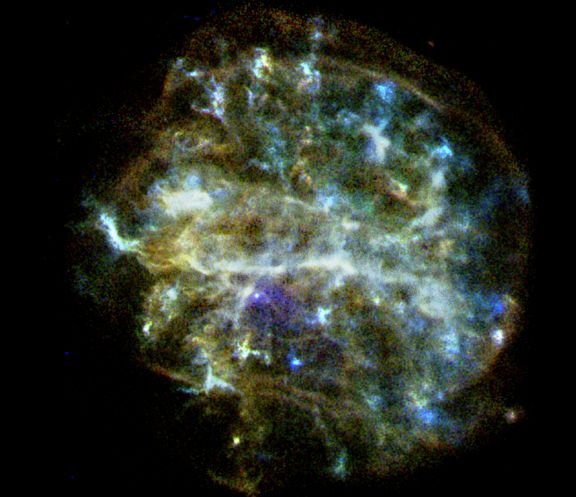Explanation: Massive stars spend their brief lives furiously burning nuclear fuel. Through fusion at extreme temperatures and densities surrounding the stellar core, nuclei of light elements like Hydrogen and Helium are combined to heavier elements like Carbon, Oxygen, etc. in a progression which ends with Iron. And so a supernova explosion, a massive star's inevitable and spectacular demise, blasts back into space debris enriched in heavier elements to be incorporated into other stars and planets (and people!). This detailed false-color x-ray image from the orbiting Chandra Observatory shows such a hot, expanding stellar debris cloud about 36 light-years across. Cataloged as G292.0+1.8, this young supernova remnant in the southern constellation Centaurus resulted from a massive star which exploded an estimated 1,600 years ago. Bluish colors highlight filaments of the mulitmillion degree gas which are exceptionally rich in Oxygen, Neon, and Magnesium. Just below and left of center, a point like object in the Chandra image suggests that the enriching supernova also produced a pulsar in its aftermath, a rotating neutron star remnant of the collapsed stellar core.
1999 2000 2001 2002 2003 2004 2005 2006 2007 2008 2009 2010 2011 2012 2013 2014 2015 2016 2017 2018 2019 2020 2021 2022 2023 2024 2025 |
Yanvar' Fevral' Mart Aprel' Mai Iyun' Iyul' Avgust Sentyabr' Oktyabr' Noyabr' Dekabr' |
NASA Web Site Statements, Warnings, and Disclaimers
NASA Official: Jay Norris. Specific rights apply.
A service of: LHEA at NASA / GSFC
& Michigan Tech. U.
|
Publikacii s klyuchevymi slovami:
nucleosynthesis - supernova remnant - nukleosintez - rentgenovskoe izluchenie - ostatok Sverhnovoi
Publikacii so slovami: nucleosynthesis - supernova remnant - nukleosintez - rentgenovskoe izluchenie - ostatok Sverhnovoi | |
Sm. takzhe:
Vse publikacii na tu zhe temu >> | |
